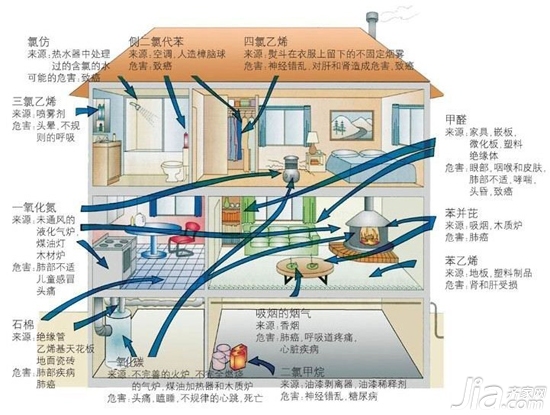Formaldehyde Formaldehyde is a colorless gas with a strong, pungent odor. It's commonly found in building materials, furniture, and household products. This chemical is known for its ability to off-gas over time, especially in newly constructed or renovated spaces. Hazard: Prolonged exposure to formaldehyde can lead to various health issues. It may cause irritation of the eyes, nose, and throat, as well as respiratory problems. Long-term exposure has been linked to more serious conditions, including chronic respiratory diseases, nasopharyngeal cancer, colon cancer, and even leukemia. In some cases, it may also affect fetal development, leading to chromosomal abnormalities in newborns. Benzene Benzene is a clear, flammable liquid with a sweet, aromatic smell. It is often found in gasoline, solvents, and certain types of adhesives. Benzene is widely used in industrial settings and is a common component in many consumer products. Hazard: Inhalation of benzene over a long period can be extremely harmful. It is a known carcinogen and has been associated with aplastic anemia, a condition where the bone marrow fails to produce enough blood cells. Aplastic anemia requires careful medical treatment, which may include blood transfusions, immunosuppressive therapy, and in severe cases, stem cell transplantation. Ammonia Ammonia is a colorless gas with a sharp, pungent odor. It dissolves easily in water and is highly irritating to the eyes, skin, and respiratory system. Ammonia is commonly found in cleaning products, fertilizers, and some types of insulation materials. Hazard: Exposure to ammonia, even at low levels, can cause irritation to the upper respiratory tract, leading to symptoms like coughing, sore throat, and difficulty breathing. Prolonged exposure may result in more severe conditions such as laryngitis, hoarseness, and pulmonary edema, which is fluid buildup in the lungs. TVOC (Total Volatile Organic Compounds) TVOC refers to a group of organic chemicals that easily evaporate into the air. These compounds are commonly found in paints, varnishes, adhesives, and other construction materials. They can contribute to poor indoor air quality, especially in tightly sealed environments. Hazard: Exposure to high levels of TVOC can cause a range of health effects, including headaches, dizziness, fatigue, and irritation of the eyes, nose, and throat. In some cases, it may lead to more serious symptoms such as chest tightness and difficulty concentrating. Proper ventilation is essential when using products that emit these compounds. Radon Radon is a radioactive, colorless, and odorless gas that comes from the natural decay of uranium in soil, rock, and water. It can seep into homes through cracks in floors, walls, and gaps around pipes. Radon is particularly prevalent in areas with granite or limestone bedrock. Hazard: Radon is the second leading cause of lung cancer in the United States, after smoking. It is considered one of the most dangerous indoor pollutants due to its invisible and odorless nature. Long-term exposure to radon increases the risk of developing lung cancer, especially in smokers or those who spend a lot of time indoors. Environmental testing, new home, formaldehyde, marble, cement, coating 302 Slot Type Thread Insert,302 Self Tapping Threaded Inserts,302 Stainless Steel Inner Thread Inserts,302 Self-Tapping Threaded Inserts Shenyang Helisert Technology Co., Ltd , https://www.helisert.com
The five biggest killers of indoor air pollution
